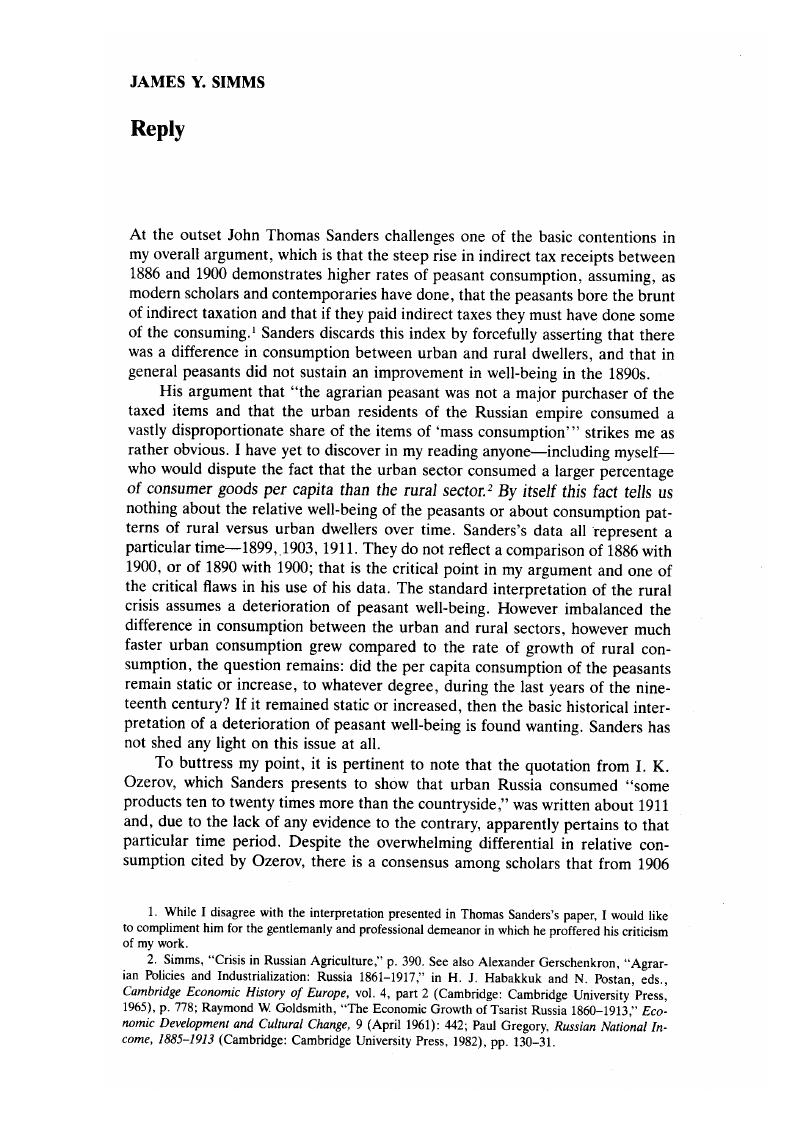No CrossRef data available.
Article contents
Reply
Published online by Cambridge University Press: 27 January 2017
Abstract

- Type
- Notes and Comment
- Information
- Copyright
- Copyright © Association for Slavic, East European, and Eurasian Studies. 1984
References
1. While I disagree with the interpretation presented in Thomas Sanders's paper, I would like to compliment him for the gentlemanly and professional demeanor in which he proffered his criticism of my work.
2. Simms, “Crisis in Russian Agriculture,” p. 390. See also Gerschenkron, Alexander, “Agrarian Policies and Industrialization: Russia 1861–1917,” in Habakkuk, H. J. and Postan, N., eds., Cambridge Economic History of Europe, vol. 4, part 2 (Cambridge: Cambridge University Press, 1965), p. 778 Google Scholar; Raymond W. Goldsmith, “The Economic Growth of Tsarist Russia 1860–1913,” Economic Development and Cultural Change, 9 (April 1961): 442; Gregory, Paul, Russian National Income, 1885–1913 (Cambridge: Cambridge University Press, 1982), pp. 130–31Google Scholar.
3. See, for example, Gerschenkron, Alexander, “Problems and Patterns of Russian Economic Development,” in Black, Cyril, ed., The Transformation of Russian Society (Cambridge, Mass.: Harvard University Press, 1960), pp. 56–57 Google Scholar.
4. Gregory, Russian National Income, pp. 130–31.
5. Simms, “Crisis in Russian Agriculture,” pp. 378, 384.
6. See Miliukov, Paul, Russia and Its Crisis (New York: Collier Books, 1962), p. 325 Google Scholar; Sergeevskii, Ivan, Golod v Rossii (Geneva: Society of Old Populists, 1892), p. 32 Google Scholar; Nikolai–on, , Ocherkinashego poreformennago khoziaistva (St. Petersburg, 1893), pp. 258–59.Google Scholar
7. Von Laue, Theodore H., “The High Cost and the Gamble of the Witte System,” in Readings in Russian History, vol. 2, ed. Harcave, Sidney (New York: Thomas Y. Crowell, 1968), p. 70.Google Scholar Emphasis added.
8. Gregory, Russian National Income, pp. 137–38.
9. Emphasis added.
10. Emphasis added.
11. See Shcherbina, F. A., “Krest'ianskie biudzhety i zavisimost’ ikh ot urozhaev i tsen na khleba,” in Chuprov, A. I. and Posnikov, A. S., eds., Vliianie urozhaev i khlebnykh tsen na nekotoriia storony russkago narodnago khoziaistva, vol. 2 (St. Petersburg, 1897), pp. 1–79 Google Scholar.
12. Volin, Lazar, A Century of Russian Agriculture: From Alexander II to Khrushchev (Cambridge,Mass.: Harvard University Press, 1970), p. 63 CrossRefGoogle Scholar.
13. Simms, “Crisis in Russian Agriculture,” p. 380.
14. I do not feel that I quoted Pavlovsky out of context, as Sanders charges in n. 41. See Simms, “Crisis in Russian Agriculture.” p. 386.
15. Ibid., pp. 380–85.


